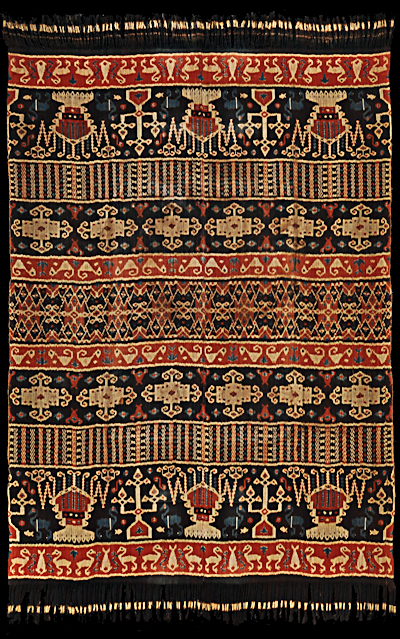| |
 
 | | | |
044 Sumba, East Sumba
Hinggi (men's blanket)  
| | Locale: | Kanatang | | Period: | Early 20th c. | | Yarn: | Cotton, hand-spun, extremely fine, double-ply | | Technique: | Warp ikat | | Panels: | 2 | | Size: | 162 x 239 cm (5' 3" x 7' 10") LW: 1.48 | | Weight: | 975 g (34.4 oz), 252 g/m2 (0.83 oz/ft2) | | Design: | Hinggi with the classic eleven band field division in hondu wallah construction, with 4-fold rather than 8-fold replication in the endfields. The outermost bands are decorated with birds, probably partridges, and sea worms. The next and widest, called hai, are decorated with manta shrimp (which around Sumba are up to a foot in length), a mark of high rank on account of their ability to outgrow their early stature and rejuvenate themselves; milkweed plants, wanggakoli; and what appear to be wading birds. Then comes a very unusual band with vertical stripes arrayed in blocks. The next carries a variant of the habak motif. This is followed by a band with small birds. The central band is decorated with the patola-inspired patola ratu motif, again a mark of high rank. The weft was done with two yarns in parallel, some sections morinda, others indigo. | | Comment: | Uncommonly large hinggi, about 15% over the average size (3.8 m2 vs. 3.3 m2). This is due to the great width. Such generous proportions are indicative of the cloth's importance. The hondu wallah construction takes twice as much work as a regular hinggi, hence is limited to the highest class, where one can afford such expenditure of labour - the lady's and the slaves'. Adams (1969:119) found shrimp and live trees to be the only stable (i.e. frequently occurring) combination pattern among the 300 early hinggi she studied. According to local sources, the combination of large shrimp, kurang, and habaku, flying lizards, suggests either Rende or Kambera as place of origin. Cloth feels brittle with age. Wildly irregular yarn gauge supports the early dating (see micro-photographs). Some light smudging largely limited to one of the rows of habak motifs. Otherwise in immaculate condition: fully intact, and with vibrant colours, probably close to their original strength. | | Background: | Chapters on Sumba and East Sumba. | | Published: | Noble Virtuosity: Hidden Asymmetry in Ikat from Sumba, 2024. | | Compare: | 361 | | Sources: | Akin to hinggi made for a ruler in McIntosh, Thread and Fire, which is even larger (166 x 255 cm). Similar to circa 1900 hinggi of normal size in Khan-Majlis, Woven Messages, Fig. 400, that likewise has shrimp and a pohon hidup, live tree, in the widest ikated bands. Also similar to a early 20th c. hinggi in Fig. 402, 404 and 408, which all have shrimp and live trees in the widest ikated band. Similar to hinggi dated as first half of the 20th c. in the Nusantara Museum collection, S 5109, which after Nusantara closed was donated to the Museum Nasional Indonesia. The photo only shows the bottom quarter of the cloth, but the text mentions that it likewise has a patola-ratu midfield. The unusual vertical stripes are also seen in a hinggi in the Tropenmuseum collection that was originally acquired by Jasper and is depicted in Van Hout, Indonesian Textiles, Fig. 211. The National Palace Museum of Taiwan holds a hinggi similarly decorated with large shrimps, though 1/3 narrower. Its entire midfield is made of vertical stripes. It appears, then, that we can add the stripes to Adam's stable combination. | | |

©Peter ten Hoopen, 2025
All rights reserved.
|
|


